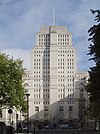UCL Medical School: Difference between revisions
Removed broken link image information |
|||
| Line 29: | Line 29: | ||
A report published in November 2005 by the Higher Education Policy Institute (HEPI) found that RFUCMS had the highest expenditure per student, an average spend of £50,103 per student, of any medical school in the country, followed closely by [[Oxford University]] Medical School (£42,348) and [[Imperial College School of Medicine]] (£38,223). |
A report published in November 2005 by the Higher Education Policy Institute (HEPI) found that RFUCMS had the highest expenditure per student, an average spend of £50,103 per student, of any medical school in the country, followed closely by [[Oxford University]] Medical School (£42,348) and [[Imperial College School of Medicine]] (£38,223). |
||
[[Image:Uclmedschoolcrests.JPG|left|230px|thumbnail|Crests of the Royal Free Hospital Medical School (L), the University College Medical School and the Middlesex Hospital Medical School (R)]] |
|||
Admission to the medical school, in common with all 32 medical schools in the UK, is extremely competitive. Prospective students must apply directly to the medical school in addition to through the Universities and Colleges Admissions Service (UCAS). Acceptable qualifications for entry include the General Certificate of Education at Advanced Level ('A' Level) at grades AAB, to include at least Chemistry and Biology, and a pass at Advanced Subsidiary Level. The International Baccalaureate (Full Diploma), although less common, is also an acceptable entry qualification. Additionally, applicants must sit an entrance exam, the Biomedical Admissions Test. |
Admission to the medical school, in common with all 32 medical schools in the UK, is extremely competitive. Prospective students must apply directly to the medical school in addition to through the Universities and Colleges Admissions Service (UCAS). Acceptable qualifications for entry include the General Certificate of Education at Advanced Level ('A' Level) at grades AAB, to include at least Chemistry and Biology, and a pass at Advanced Subsidiary Level. The International Baccalaureate (Full Diploma), although less common, is also an acceptable entry qualification. Additionally, applicants must sit an entrance exam, the Biomedical Admissions Test. |
||
Revision as of 16:18, 23 July 2007
| Rfucms.jpg | |
| Type | Medical school |
|---|---|
| Established | 1987 |
| Dean | Professor K Michael Spyer |
| Location | , |
| Affiliations | University College London, University of London |
| Website | http://www.ucl.ac.uk/medicalschool |
The Royal Free and University College Medical School (RFUCMS) is the medical school of University College London. It was formed in 1998 following a series of mergers between a number of existing medical schools: in 1987 the Middlesex Hospital Medical School (founded 1746) merged with University College Medical School (1825) to form the University College and Middlesex School of Medicine. In 1998 the University College and Middlesex School of Medicine merged with the Royal Free Hospital Medical School to form the present Royal Free and University College Medical School.
The medical school is one of the largest in the country with a yearly intake of 330 students. Undergraduate teaching is spread across three campuses based in Bloomsbury (the Cruciform, University College Hospital, the Elizabeth Garrett Anderson and Obstetrics Hospitals), at Archway (the Whittington Hospital and the former Royal Holborn Infirmary) and in Hampstead at the Royal Free Hospital.
A report published in November 2005 by the Higher Education Policy Institute (HEPI) found that RFUCMS had the highest expenditure per student, an average spend of £50,103 per student, of any medical school in the country, followed closely by Oxford University Medical School (£42,348) and Imperial College School of Medicine (£38,223).
Admission to the medical school, in common with all 32 medical schools in the UK, is extremely competitive. Prospective students must apply directly to the medical school in addition to through the Universities and Colleges Admissions Service (UCAS). Acceptable qualifications for entry include the General Certificate of Education at Advanced Level ('A' Level) at grades AAB, to include at least Chemistry and Biology, and a pass at Advanced Subsidiary Level. The International Baccalaureate (Full Diploma), although less common, is also an acceptable entry qualification. Additionally, applicants must sit an entrance exam, the Biomedical Admissions Test.
The course in medicine at UCL leads to the award of the MB BS BSc(Hons) degrees and takes six years to complete; 2 years of preclinical medicine, 3 years of clinical medicine, and 1 year studying for an intercalated degree, which at UCL is compulsory for all students except postgraduates. For particularly motivated students there is also the opportunity to intercalate a PhD, which is achieved in 2 years rather than the normal 3 required for a doctoral qualification.
Associated institutes and bodies

- The Institute of Child Health (Great Ormond Street Hospital for Sick Children)
- The Institute of Neurology (the National Hospital for Neurology and Neurosurgery)
- The Institute of Laryngology and Otology
- The Institute of Ophthalmology (Moorfields Eye Hospital)
- The Institute of Orthopaedics
- The Institute of Urology and Nephrology
- The Institute of Nuclear Medicine
- The Ludwig Institute for Cancer Research
- The Wolfson Institute for Biomedical Research
- The National Institute for Medical Research (NIMR)
RUMS Clubs and Societies
As well as being able to join all the UCL Clubs and Societies, Medical Students can also join RUMS Clubs and Societies. Some people argue that RUMS Clubs and Societies are the best part of RUMS. With a large range of societies (including those not listed here) the Royal Free and University College Medical School is one of the most sociable Medical Schools in London, just pop into Huntley Street on a Wednesday night.
Sports
- Badminton
- Basketball
- Boat Club
- Cricket
- Men's Football
- Women's Football
- Men's Hockey
- Women's Hockey
- Netball
- Rugby
- Squash
- Tennis
Societies
- MD's Comedy Revue
- Christian Medics
- Islamic Society
- Surgical Society
- Medical Ethics
- Medsin
- Music Society
- RUMS RAG
- Spectrum

